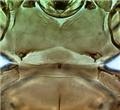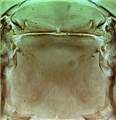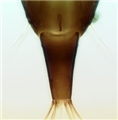Bagnalliella yuccae
Recognition data
Distinguishing features
Female fully winged, also female and male with wings shorter than thorax width. Body and legs brown, tarsi and apices of fore tibiae yellow; antennal segments III � VII largely yellow, VII shaded at apex, VIII light brown; fore wings pale. Head longer than wide; cheeks confluent with eyes, with small grooves anterolaterally; postocular setae wide apart, bluntly pointed; dorsal surface with little sculpture; maxillary stylets retracted to eyes, about one fifth of head width apart. Antennae 8-segmented; segment III with two sensoria, IV with four sensoria; segment VIII narrowed to base. Pronotum with little sculpture; three pairs of prominent, almost capitate, major setae; anteromarginals minute, midlaterals variable but never as long as epimerals; paired prosternal basantra well developed, mesopresternum slender at mid-point. Fore tarsus with minute tooth. Metanotum faintly reticulate. Forewings weakly constricted medially; 5 duplicated cilia present. Pelta almost without sculpture, D-shaped; tergites II � VII with two pairs of sigmoid wing-retaining setae; tergite IX setae S1 almost pointed, as long as tube. Male similar, with fore tarsal tooth slightly larger; tergite IX setae S2 short and stout.
Related and similar species
Nine species are listed in the genus Bagnalliella. Seven of these are from Yucca plants in southwestern USA and are clearly closely related in structure, whereas the other two (from New Guinea and South Africa) should probably be placed in other genera. B. yuccae has been distributed widely around the world in association with its cultivated host-plant. Cott (1956) distinguished the three species of Bagnalliella recorded from California on the following basis: B. yuccae has two sensoria on antennal segment III and four on IV; B. mojave Hood has one sensorium on antennal segment III and two on IV; B. desertae Hood has one sensorium on antennal segment III and three (? four) on IV. Despite this, variation in the number of these sensoria within and between populations requires further study.
Taxonomic data
Current valid name
Bagnalliella yuccae (Hinds)
Original name and synonyms
Cephalothrips yuccae Hinds, 1902: 194
Haplothrips ryani Moulton, 1929: 131
Haplothrips yuccae Savenko, 1944: 1005
Family placement
Phlaeothripidae, Phlaeothripinae
Biological data
Life history
Larvae and pupae found together with adults on leaf bases.
Host plants
Yucca spp.
Tospoviruses vectored
None
Crop damage
Mottling leaf bases of cultivated Yucca plants
Distribution data
Area of origin
Western USA
Distribution
Widespread around the world on cultivated Yucca plants








